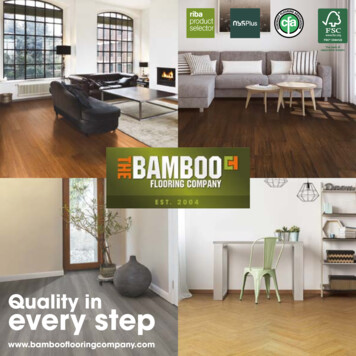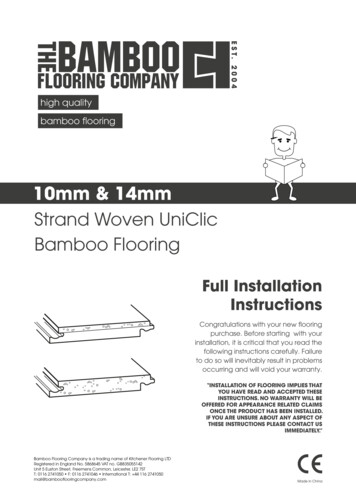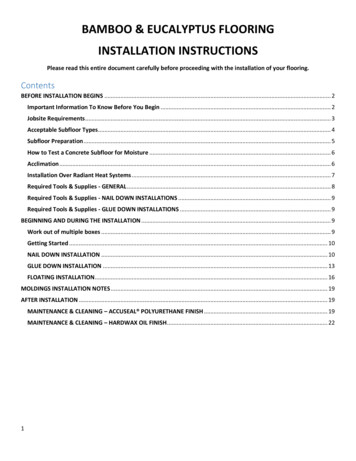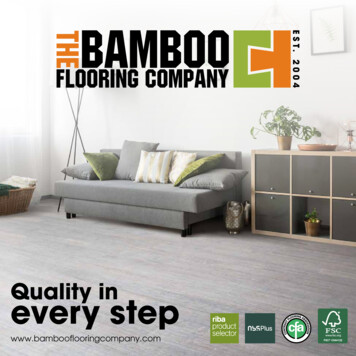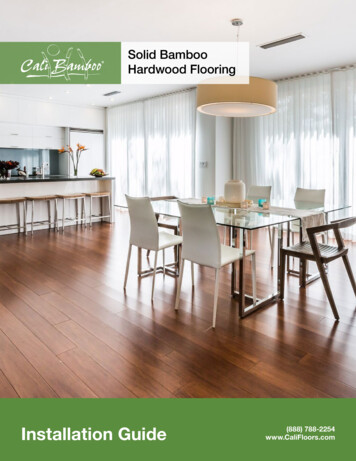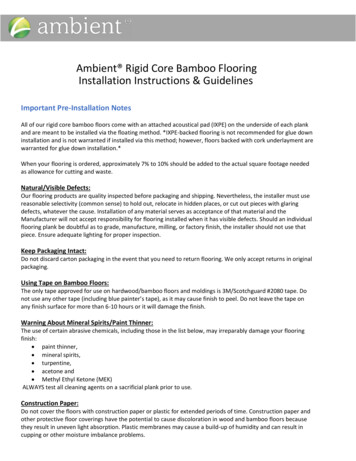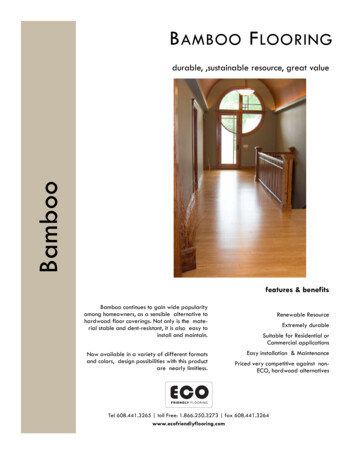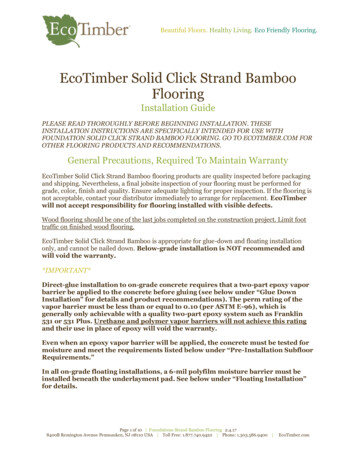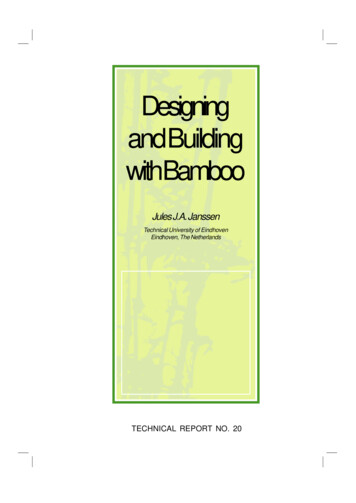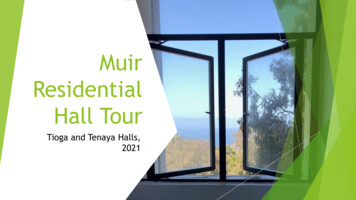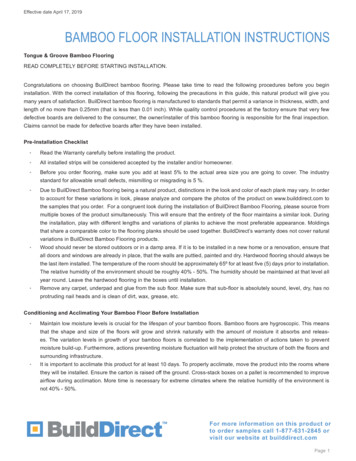
Transcription
Effective date April 17, 2019BAMBOO FLOOR INSTALLATION INSTRUCTIONSTongue & Groove Bamboo FlooringREAD COMPLETELY BEFORE STARTING INSTALLATION.Congratulations on choosing BuilDirect bamboo flooring. Please take time to read the following procedures before you begininstallation. With the correct installation of this flooring, following the precautions in this guide, this natural product will give youmany years of satisfaction. BuilDirect bamboo flooring is manufactured to standards that permit a variance in thickness, width, andlength of no more than 0.25mm (that is less than 0.01 inch). While quality control procedures at the factory ensure that very fewdefective boards are delivered to the consumer, the owner/installer of this bamboo flooring is responsible for the final inspection.Claims cannot be made for defective boards after they have been installed.Pre-Installation Checklist Read the Warranty carefully before installing the product. All installed strips will be considered accepted by the installer and/or homeowner. Before you order flooring, make sure you add at least 5% to the actual area size you are going to cover. The industrystandard for allowable small defects, mismilling or misgrading is 5 %. Due to BuilDirect Bamboo flooring being a natural product, distinctions in the look and color of each plank may vary. In orderto account for these variations in look, please analyze and compare the photos of the product on www.builddirect.com tothe samples that you order. For a congruent look during the installation of BuilDirect Bamboo Flooring, please source frommultiple boxes of the product simultaneously. This will ensure that the entirety of the floor maintains a similar look. Duringthe installation, play with different lengths and variations of planks to achieve the most preferable appearance. Moldingsthat share a comparable color to the flooring planks should be used together. BuildDirect’s warranty does not cover naturalvariations in BuilDirect Bamboo Flooring products. Wood should never be stored outdoors or in a damp area. If it is to be installed in a new home or a renovation, ensure thatall doors and windows are already in place, that the walls are puttied, painted and dry. Hardwood flooring should always bethe last item installed. The temperature of the room should be approximately 65º for at least five (5) days prior to installation.The relative humidity of the environment should be roughly 40% - 50%. The humidity should be maintained at that level allyear round. Leave the hardwood flooring in the boxes until installation. Remove any carpet, underpad and glue from the sub floor. Make sure that sub-floor is absolutely sound, level, dry, has noprotruding nail heads and is clean of dirt, wax, grease, etc.Conditioning and Acclimating Your Bamboo Floor Before Installation Maintain low moisture levels is crucial for the lifespan of your bamboo floors. Bamboo floors are hygroscopic. This meansthat the shape and size of the floors will grow and shrink naturally with the amount of moisture it absorbs and releases. The variation levels in growth of your bamboo floors is correlated to the implementation of actions taken to preventmoisture build-up. Furthermore, actions preventing moisture fluctuation will help protect the structure of both the floors andsurrounding infrastructure. It is important to acclimate this product for at least 10 days. To properly acclimate, move the product into the rooms wherethey will be installed. Ensure the carton is raised off the ground. Cross-stack boxes on a pallet is recommended to improveairflow during acclimation. More time is necessary for extreme climates where the relative humidity of the environment isnot 40% - 50%.For more information on this product orto order samples call 1-877-631-2845 orvisit our website at builddirect.comPage 1
BAMBOO FLOOR INSTALLATION INSTRUCTIONSTesting Moisture Levels in SubfloorGeneral: Measure the moisture content within the subfloor before proceeding with the installation. Be sure to identify and rid thesource of excessive moisture before progressing further. Be sure to lengthen the time of acclimation and allow for further ventilationof the product until it is in suitable condition. At this point, your product is ready for moisture barriers to be applied. Moisture maybe prone to varying with seasonal change. For this reason, results of moisture tests are only applicable during the day of testing.Moisture barriers must always be applied for every installation of BuilDirect Bamboo flooring. BuildDirect does not cover warranty formoisture related issues or damages. When tests show that moisture vapor levels are flush with, or exceeding 12%, they will need tobe corrected and lowered before the installation can commence.Wood/Bamboo Subflooring: When tests show that moisture vapor levels are flush with, or exceeding 12%, they will need to becorrected and lowered before the installation can commence. Wood/Bamboo flooring must always be installed with a vapor barrier.BuildDirect will always recommend the use of vapor barriers, specifically when moisture content levels of the subfloors and floorsare surmounting 3%.Concrete Subflooring: Concrete subfloors have to be tested for moisture vapor pressure in various locations in order to providedependable results. In the case where results conclude that moisture vapor is at or exceeding the required vapor content, concrete floors must be installed with an impermeable vapor retarder with a perm level lower than .13. This retarder must be able topermanently deter moisture vapor.Other Considerations:Before installation, lay out the flooring where it is to be installed (that is, lay the planks down roughly as they will appear afterinstallation), taking care to mix it in a shading pattern pleasing to your eye. Installer should inspect each plank at this time for finishand quality. Once installed, it becomes the responsibility of the installer/homeowner. Remember that all natural flooring comes in arange of colors and shades. Our quality control procedures at the factory ensure that very few, if any defective planks are delivered tothe consumer. Remove baseboards and undercut door jambs to insure a quality installation. Remember to allow room for expansionaround the entire perimeter of the flooring. Failure to provide room for expansion will result in installation issues.Tips and MaintenancePractical Tips-Installation of a factory-finished hardwood floor requires more care than a conventional floor to prevent damaging the floor’sfinish during installation. Frequent use of a vacuum cleaner during installation is highly recommended to eliminate saw dustand wood chips.-Place your tools on the plywood or on a piece of cardboard rather than directly on the hardwood floor.-To better hide the expansion joint around the room, cut the gypsum so that the wood can use that space as an expansionjoint.-If a strip presents too much color variation or a minor defect, put it aside and use it in a less visible area such as a closet.You can also cuta defective strip and use it to start or end a row.-Save remaining strips after installation and store them in a proper place for future repairs.-Remove adhesive from surface of the floor as soon as possible.For more information on this product orto order samples call 1-877-631-2845 orvisit our website at builddirect.comPage 2
BAMBOO FLOOR INSTALLATION INSTRUCTIONSMaintenance-Use non-wax flooring cleaner to keep your floor in good condition. Use of conventional, domestic cleaners may permanentlydamage your floor’s finish.-Never clean your hardwood floor with a wet mop or cloth. Water and wood are natural enemies.-Do not wax your hardwood floor.-Vacuum your floor frequently to eliminate the presence of solid particles (such as sand) which may damage and/or scratchyour floor.-Place protective felt underneath your furniture to protect your floor. Clean the felt regularly and replace it when necessary.-When moving heavy furniture (fridge, piano, etc.), place a thick rug underneath furniture legs before movingInstallation Methods Covered In This Guide: T&G - Nail-down Method T&G - Floating Method Click Lock - Floating MethodInstalling Bamboo Flooring on Top of a Wood Subfloor (Nail-down Method)Installation Requirements Gypsum joints must be completed and dried. Concrete work must have been completed at least 45 days prior to installation. The heating system must be functional and the building must be heated up to 65 F for a minimum of 7 days immediatelyprior to installation. The relative humidity of the building must be between 40% and 50%. Plywood humidity (subfloor) must not exceed 12%. Subfloor thickness must be a minimum of ¾” Particle boards or chipboards must not be used as the subfloor.Before Installing It is important to acclimate this product for at least 10 days. To properly acclimate, move the product into the rooms wheretheywill be installed. Ensure the carton is raised off the ground. Cross-stack boxes on a pallet is recommended toimprove airflow during acclimation. More time is necessary for extreme climates where the relative humidity of theenvironment is not 40% - 50%. Make sure the subfloor (plywood) is properly attached to the joists to avoid creaking. Correct slight irregularities on the subfloor with a sander. All the nails and screws of the subfloor must be driven in properly. Remove baseboards and doorsills. Cut 2cm (9/16”) off the bottom of the doorframes to insert the strips underneath them. Vacuum the subfloor regularly during installation to make sure it is always clean and dust free. A vapor barrier or felt paper (#15) placed between the subfloor and the strips will help keep the humidity content of theFor more information on this product orto order samples call 1-877-631-2845 orvisit our website at builddirect.comPage 3
BAMBOO FLOOR INSTALLATION INSTRUCTIONSflooring more stable. 1 ¼” minimum length, 15-gage nails, or staples are recommended to fasten the floor.Installation Guide1.When installing your floor, be sure to use a moisture barrier that is compatible with the flooring product2.Always lay flooring perpendicular to the floor joist when nailing in the product.3.BuilDirect Bamboo flooring products will expand with moisture. To account for this, please leave a 1/2” space around theoutside area of the room as well as vertical standing objects that use spacers.4.Before nailing in any boards, plan out your layout plan by placing boards in the desired positions (dry lay).5.Use a sample plank to test the air pressure and angle of your pneumatic nailer is correct before you start your floorinstallation. Correct and adjust the pneumatic nailer based on any surface or tongue damages to the sample plank. Do notstart the installation until you find a suitable setting that will not damage the planks.6.Refrain from starting the installation in the middle of the flooring area. Use the walls of the room to make sure your planks arestraightly aligned.7.Glue or blind nail your initial row of planks.8.Connect the planks together by matching the mating side of the first plank with the shorter side of the side plank.9.Once you get to the end of the row, cut off the excess length of the last plank and start the second row.10. End joints of each consecutive row must be offset by a minimum of six inches in order to achieve the most aesthetic appearance.11. Move on to the second row and make sure to connect the short plank edges with those of the longer edges.12. Start the third row by nailing above the tongue without deviation at a 45 degree angle.13. Keep an eye on the pressure of the nailer to ensure the nails are not driven deeper than need be. If the nail goes too deeplythrough the nail pocket or is not correctly sitting in the nail pocket, your bamboo floors will not allow for the next plank toproperly be installed in unison to the other planks.14. A nail spacing of 8 to 10 inches along long side of the board is the most ideal when installing your flooring.15. Do not nail any closer than 4 inches from the end of the board to avoid plank damage and installation problems.16. With the remaining rows, first connect the short edges of each plank and then tap the long edges together with a pull bar.17. Throughout the installation, make sure to double check that your floor is being installed straight.18. Planks may need to be cut in the last row to properly fit.19. The process that was used to install the first two rows of planks must be again used to install the last two rows.Installing Bamboo Floors on Top of a Concrete Subfloor (Floating Method)Important Notices The adhesive has to be a 100% Urethane-based product. The adhesive manufacturer’s installation instructions are to be followed.Installation Requirements Gypsum joints must be completed and dried.For more information on this product orto order samples call 1-877-631-2845 orvisit our website at builddirect.comPage 4
BAMBOO FLOOR INSTALLATION INSTRUCTIONS Concrete work must have been completed at least 45 days prior to installation. The heating system must be functional and the building must be heated up to 65 F for a minimum of 7 days immediatelyprior to installation. The relative humidity of the building must be between 40% and 50%Before Installing It is important to acclimate this product for at least 10 days. To properly acclimate, move the product into the rooms wheretheywill be installed. Ensure the carton is raised off the ground. Cross-stack boxes on a pallet is recommended toimprove airflow during acclimation. More time is necessary for extreme climates where the relative humidity of theenvironment is not 40% - 50%. Correct slight irregularities on the subfloor. Remove baseboards and doorsills. Cut 9/16” off the bottom of the doorframes to insert the strips underneath them. Vacuum the subfloor regularly during installation to make sure it is always clean and dust free.Installation Guide1.Please use Tongue & Groove Bamboo Flooring Glue for all BuilDirect Bamboo floating floor installations.2.Pleas ensure that the subfloor, job site, and environment are suitable for bamboo flooring before commencing yourinstallation.3.Before you start your installation, be sure to coat concrete subfloors with moisture control sealing products to preventmoisutre buildup.4.BuilDirect Bamboo flooring products will expand with moisture. To account for this, please leave a 1/2” space around theoutside area of the room as well as vertical standing objects that use spacers.5.Before nailing in any boards, plan out your layout plan by placing boards in the desired positions (dry lay).6.Refrain from starting the installation in the middle of the flooring area. Use the walls of the room to make sure your planksare straightly aligned.7.To start, place your first plank in the corner so it borders both corners of the wall. Make sure the longer, grooved side isagainst the longer wall.8.Drip a consistent thin line of glue across the underside of the groove in the plank.9.Connect the planks together by matching the mating side of the first plank with the shorter side of the side plank.10. Once you get to the end of the row, cut off the excess length of the last plank and start the second row.11. End joints of each consecutive row must be offset by a minimum of six inches in order to achieve the most aestheticappearance.12. Move on to the second row and make sure to connect the short plank edges with those of the longer edges.13. When finishing the row and trimming the last plank to fit to the row, be sure to leave room for the planks to expand. This isin order to prevent damage to both the rest of the floor as well as your foundation.14. With the remaining rows, first connect the short edges of each plank and then tap the long edges together with a pull bar.For more information on this product orto order samples call 1-877-631-2845 orvisit our website at builddirect.comPage 5
BAMBOO FLOOR INSTALLATION INSTRUCTIONSInstalling Click Lock Bamboo Floors (Floating Method)Installation Requirements Gypsum joints must be completed and dried. Concrete work must have been completed at least 45 days prior to installation. The heating system must be functional and the building must be heated up to 65 F for a minimum of 7 daysimmediately prior to installation. The relative humidity of the building must be between 40% and 50%Before Installing It is important to acclimate this product for at least 10 days. To properly acclimate, move the product into the rooms wheretheywill be installed. Ensure the carton is raised off the ground. Cross-stack boxes on a pallet is recommended toimprove airflow during acclimation. More time is necessary for extreme climates where the relative humidity of theenvironment is not 40% - 50%. Correct slight irregularities on the subfloor. Remove baseboards and doorsills. Cut 9/16” off the bottom of the doorframes to insert the strips underneath them. Vacuum the subfloor regularly during installation to make sure it is always clean and dust free.Installation GuideMethod A: Position the plank at a 20-30 angle to the plank already installed. Move the plank gently up and down while pushingforward. The plank will then automatically fold into place. You can either insert the tongue into the groove or the groove on to thetongue. The tongue in groove method is most common, and also the easiest. Never force the plank to lay flat, always help it to foldinto position. See Diagrams A-1 through A-3.Method B: You can also tap the planks into place with a tapping block and hammer without lifting the planks. For this method you willneed a special tapping block designed for 4/2 inch (42mm) flooring. The planks should not be tapped together with a single tap. Toavoid damaging the plank, you must tap them together gradually. See Diagrams B-1 and B-2.For more information on this product orto order samples call 1-877-631-2845 orvisit our website at builddirect.comPage 6
BAMBOO FLOOR INSTALLATION INSTRUCTIONSRemove all wall base or molding, and undercut door trims if needed. When installing over concrete or a crawl space, you will need to usea vapor barrier; you can use polyethylene film (6 mm or more thickness) for this purpose (Figure 4). Overlap the seams by 4 – 6 inches(404.6 – 452 mm), and then tape the seams to provide a seamless moisture barrier. Put down the plastic film as necessary until youcomplete that section, this will help to keep the moisture barrier from getting damaged. Allow the film to run up the wall a shortdistance; then trim so it will be covered by wall molding (Figure 2). When starting the installation, it is important to take time to planthe installation; accurate measurements will allow you to avoid having to cut small strips when you reach the other side of the room.If necessary, you may need to trim the starting row width so that you can avoid very thin strips of flooring when you reach the otherside of the room.To start, the sides of the planks that will go next to the wall will need to have the tongue portion removed (Figure 3) to allow room forexpansion. You will also need to take a board and cut off one third; these two pieces will be used to begin the second and third rows.Follow the procedures shown in Figures 4.3 – 4.50 for the first four rows; you can then push these rows into place along the wall. Besure to use spacers or scrap pieces of flooring along the wall to maintain expansion gap. At this point, you can avoid a stair step jointpattern by using the pieces of boards cut off when finishing a row (or cut new ones). Be sure these pieces are at least 8 inches (203mm) long. Always keep the end joints at least 8 inches (203 mm) apart. You can then finish the room as shown in Figures 4.11 – 4.16.Please Note: Be sure there is sufficient room for expansion along all walls, under door frames, and around any pipes or fixturesattached to or come through the subfloor. Rooms longer than 40 feet (52.592 m) will require an expansion gap (you can decide whereyou think it will look best), which can be finished with the T-Molding. When installing in other rooms, leave an expansion gap directlybeneath the door; this can then be covered with the T-Molding. Never attach the flooring directly to the subfloor as it will prevent thefloor from expanding/ contracting.For more information on this product orto order samples call 1-877-631-2845 orvisit our website at builddirect.comPage 7
BAMBOO FLOOR INSTALLATION INSTRUCTIONSFor more information on this product orto order samples call 1-877-631-2845 orvisit our website at builddirect.comPage 8
BAMBOO FLOOR INSTALLATION INSTRUCTIONSIn places where you cannot use the tapping block to push the boards into place, you will need to use the pull bar. You can then gentlytap the boards in place. This is necessary for the last board in each row and when finishing the last row. See Diagrams 5A – 5C.Pipes:In rows where there is a pipe or other object through the subfloor, make sure the object lines up exactly where two boards will meeton the short ends. Take care to measure carefully before cutting, so the two boards end at the middle of the object. Use a drill or holebit that is the diameter of the pipe or object, plus 3/4 inch (20mm) for expansion. Click the two short sides of the boards together,then drill the hole centered on the joint between the boards as shown. Now you can separate the two boards and install as normal.See Diagrams 6A – 6C.Under door frames:When sawing boards that will go under the door frame, you need to be sure to leave 3/8 inch (70mm) for expansion under the doorframe. When undercutting the door frame, be sure you cut far enough under, so that the frame covers the board, and still has enoughroom for expansion. Use the tapping block to gently tap the board into place, and then use the pull bar to gently tap into place.Remember that this board needs to end so that the transition piece used in the doorway ends directly under the middle of the door,plus the expansion gap. If you are installing in the adjacent room, the T-Molding should be centered under the door. See Diagrams7A & 7B.For more information on this product orto order samples call 1-877-631-2845 orvisit our website at builddirect.comPage 9
BAMBOO FLOOR INSTALLATION INSTRUCTIONSTransitions:All transition pieces should be attached to the subfloor with a high quality construction adhesive available at all Home Centers andHardware stores. Place a generous bead of adhesive under the part of the transition that will sit directly on the subfloor, and thenpress the transition firmly in place. Be sure the transition sits firmly in the adhesive, and take care not to get any adhesive on thefinish. Remove any adhesive from the finish immediately with mineral spirits and buff off any residue with a dry soft cloth. It may benecessary to place heavy weights onthe transition until the adhesive dries to ensure it will lay flat. If necessary, you can also usesmall finish nails by pre-drilling, countersinking, and then filling the nail hole with matching putty. Never attach the transitions directlyto the flooring.Finishing the floor:Remove spacers around the perimeter of the floor, then replace existing or install new wall base or molding. Never nail the wallbase or molding directly to the flooring. CONGRATULATIONS! You can now enjoy your beautiful new floor!For more information on this product orto order samples call 1-877-631-2845 orvisit our website at builddirect.comPage 10
installation. With the correct installation of this flooring, following the precautions in this guide, this natural product will give you . many years of satisfaction. BuilDirect bamboo flooring is manufactured to standards that permit a variance in thickness, width, and length of no more than 0.25mm (that is less than 0.01 inch).
